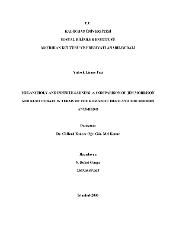| dc.contributor.advisor | Endres, Clifford W. | en_US |
| dc.contributor.author | Cengiz, Nuran Buket | |
| dc.date.accessioned | 2019-07-12T08:36:14Z | en_US |
| dc.date.available | 2019-07-12T08:36:14Z | en_US |
| dc.date.issued | 2005 | en_US |
| dc.identifier.uri | https://hdl.handle.net/20.500.12469/2005 | |
| dc.description.abstract | The Romantic hero represented the last ring in the long chain of heroism. With the Romantic hero the idea of heroism began to be transformed into the idea of anti-heroism. Thus the Romantic hero was on the one hand the last of the heroes and on the other hand the first of the anti-heroes. in the Modernist literature of the 20th century the anti-hero came onto the stage. in a similar way to what happened in literature a transition from the Romantic hero to the modern anti-hero emerged in the popular culture. This can be seen in Jim Morrison and Kurt Cobain. Jim Morrison emerged as the hero of the neo-Romantic 1960s bearing the characteristics of the anti-hero but still being a hero. in his time the neo-Romantic zeitgeist of the era together with the idea of spectacle in rock concerts laid the groundwork for a hero to emerge. in the post-punk era of rock?n?roll history there was no room for a hero. The icon of the post-punk era could only be an anti-hero. This anti-hero was Kurt Cobain. Kurt Cobain did not fit the stereotypical punk anti-rockstar model but instead bore Romantic characteristics as well although this did not turn him into a Romantic hero. Jim Morrison as a Romantic hero embodied the characteristics of both the hero and the anti-hero. in this thesis it is discussed that Jim Morrison and Kurt Cobain were both similar to and different from each other in terms of heroism and anti-heroism. -- Abstract'tan. | en_US |
| dc.description.abstract | Romantik kahraman, kahramanlık kavramının uzun tarihçesindeki son halkayı temsileder. Romantik kahramanın belirmesiyle, kahramanlık kavramı anti-kahramanlık kavramınadönüşmeye başlamıştır ve sonucunda 20. yüzyılın Modernist edebiyatında anti-kahramanortaya çıkmıştır.Edebiyatta gerçekleşen sürece benzer biçimde, popüler kültürde de Romantikkahramandan modern anti-kahramana bir geçiş yaşanmıştır. Bu geçiş, Jim Morrison ve KurtCobain arasında gözlemlenebilir. Jim Morrison neo-Romantik 1960'ların kahramanı olarakbelirir, anti-kahraman özellikleri göstermekle beraber yine de bir kahramandır. Onunzamanında, dönemin neo-Romantik ruhu rock konserlerindeki gösteri atmosferiyle birleşerekbir kahramanın ortaya çıkması için uygun zemini hazırlamıştır. Rock'n'roll tarihinin post-punk dönemindeyse bir kahramana yer yoktur. Bu nedenle post-punk dönemin ikonu ancakbir anti-kahraman olabilir, bu anti-kahraman Kurt Cobain olmuştur.Kurt Cobain stereotipik punk, anti-rock yıldızı modeline uymaz, Romantikkarakteristikler de gösterir, her ne kadar bu onu Romantik kahramana dönüştürmese de. JimMorrison da, bir Romantik kahraman olarak, hem kahraman hem de anti-kahramanözelliklerine sahiptir. Bu tezde, Jim Morrison ve Kurt Cobain'in kahraman, anti-kahramankavramları açısından birbirleriyle hem benzerlikler hem de farklılıklar gösterdikleritartışılmaktadır.Not: Sayfa 74'teki Figür I (Jim Morrison fotoğrafı) ve sayfa 75'teki Figür II (KurtCobain fotoğrafı) JPEG formatında kaydedilmiş olarak ve sırasıyla ?jim_morrison.jpg? ve?kurt_cobain.jpg? kodlarıyla CD'de yer almaktadır. | en_US |
| dc.language.iso | tur | en_US |
| dc.publisher | Kadir Has Üniversitesi | en_US |
| dc.rights | info:eu-repo/semantics/openAccess | en_US |
| dc.subject | N/A | en_US |
| dc.title | Melancholy and infinite sadness: a comparison of Jim Morrison and Kurt Cobain in terms of the romantic hero and the modern anti-hero | en_US |
| dc.type | masterThesis | en_US |
| dc.department | Enstitüler, Lisansüstü Eğitim Enstitüsü, Amerikan Kültürü ve Edebiyatı Ana Bilim Dalı | en_US |
| dc.relation.publicationcategory | Tez | en_US |
| dc.identifier.yoktezid | 187912 | en_US |
















